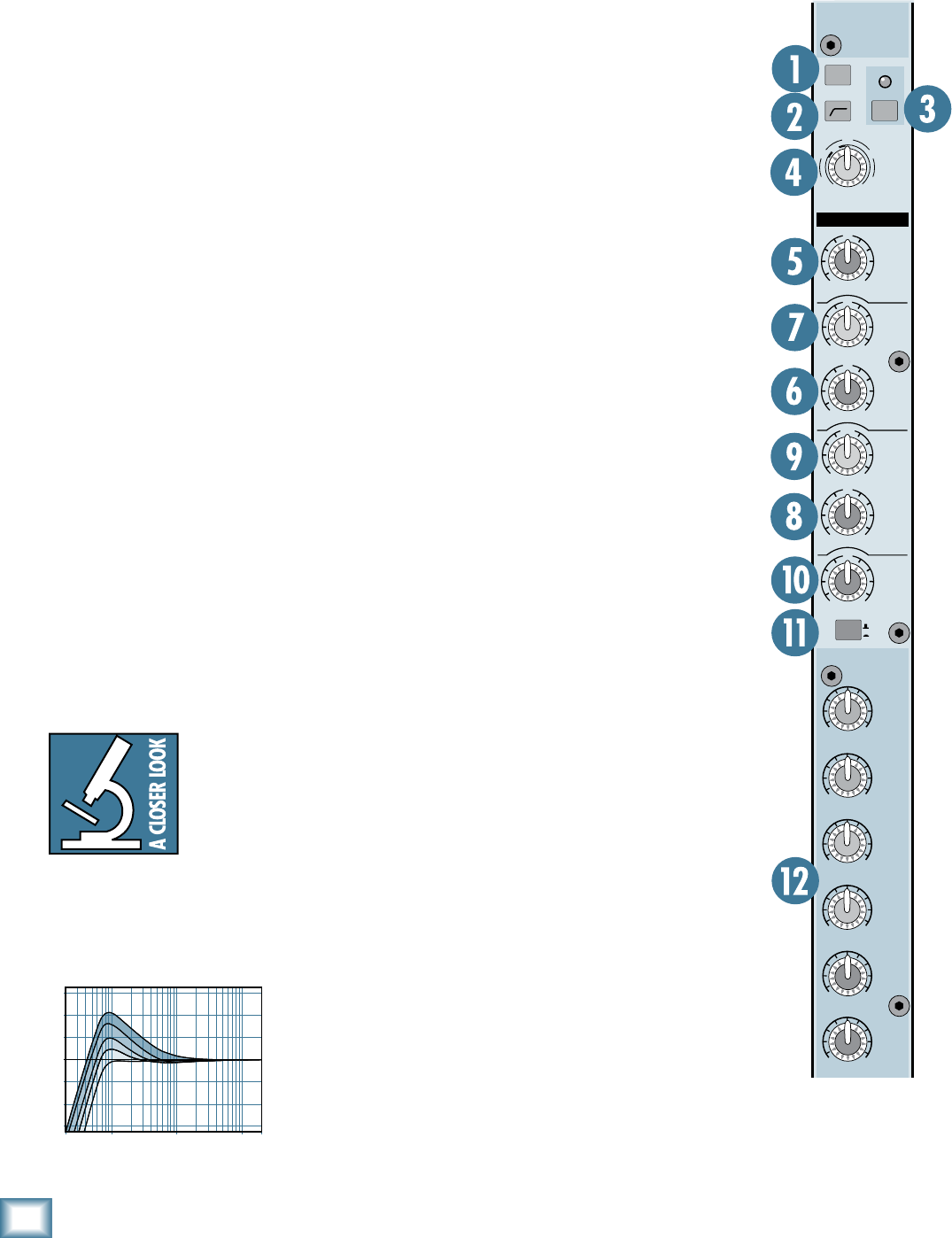
10
ONYX 4•Bus
ONYX 4•Bus
Onyx 4•Bus Features
Mono Channel Strips
The Onyx 24•4 has 20 mono channel strips and two
stereo channels, and the Onyx 32•4 has 28 mono channel
strips and two stereo channels. Each mono channel has a
mic and line input connector and an insert jack for con-
necting an external signal processor.
1. PAD Switch
In most cases, you will leave the PAD switch out. How-
ever, you may have a microphone that produces a higher
output signal than usual, which may require you to turn
the GAIN control way down.
If that is the case, push in
the PAD switch to insert a 20 dB pad at the input to the
mic preamp, to prevent overloading the microphone pre-
amp and provide better gain control.
. Low-Cut Switch
The Low-Cut switch, often referred to as a high-pass
filter, cuts bass frequencies below 100 Hz at a rate of 18 dB
per octave.
We recommend that you use the Low-Cut switch on
every microphone application except kick drum, bass
guitar, bassy synth patches, or recordings of earth-
quakes. These aside, there isn’t much down there that
you want to hear, and filtering it out makes the low stuff
you do want much more crisp and tasty. Not only that,
but the Low-Cut switch can help reduce the possibility
of feedback in live situations and it helps to conserve
amplifier power.
Another way to use the Low-Cut switch
is in combination with the LOW EQ on
vocals during live performances.
Many
times, bass shelving EQ can really ben-
efit voices. Trouble is, adding LOW EQ
also boosts stage rumble, mic handling
clunks, and breath pops. Low Cut removes all those prob-
lems so you can add LOW EQ without losing a woofer.
Here’s what the combination of LOW EQ and Low Cut
looks like in terms of frequency curves.
. 48V Phantom Power Switch
Most professional condenser mi-
crophones require phantom power,
which is a low-current DC voltage
delivered to the microphone on
pins 2 and 3 of the XLR microphone
connector. Push in the 48V switch
if your microphone needs phantom
power. An LED lights just above the
switch to indicate that phantom
power is active on that channel.
Dynamic microphones, like
Shure’s SM57 and SM58, do not
require phantom power. However,
phantom power will not harm most
dynamic microphones should you
accidentally plug one in while the
phantom power is turned on. Be
careful with older ribbon micro-
phones. Check the manual for your
microphone to find out for sure
whether or not phantom power can
damage it.
Note: Be sure the MAIN MIX fader
[72] is turned down when connect-
ing microphones to the MIC Inputs,
especially when phantom power is
turned on, to prevent pops from get-
ting through to the speakers.
4. GAIN Control
If you haven’t already, please read
“Set the Levels” on page 5.
The GAIN control adjusts the input
sensitivity of the mic and line inputs.
This allows the signal from the out-
side world to be adjusted to optimal
internal operating levels.
If the signal is plugged into the
XLR jack, there is 0 dB
of gain
(unity gain) with the knob turned
all the way down, ramping up to 60
dB of gain fully up (–20 dB to +40
dB with the PAD switch pushed in).
When connected to the 1/4" jack, there is 20 dB of
attenuation all the way down, and 40 dB of gain fully up,
with a “U” (unity gain) mark at about 10:00.
20Hz 100Hz 1kHz 10kHz 20kHz
–15
–10
–5
0
+5
+10
+15
Low Cut with Low EQ Boosted
10
dB
30
20
10
O O
40
5
5
U
60
50
AUX
1
GAIN
+
40dB
U
-
20dB
U
20
30
40
60
OUT
IN
EQ
LOW
80 Hz
HIGH
12kHz
LOW
MID
HIGH
MID
U
+15
-
15
U
+15
-
15
U
+15
-
15
U
+15
-
15
FREQ
2k
8k 400
FREQ
400
2k 1 00
4
3
2
1
5
6
O O
MAX
O O
MAX
O O
MAX
O O
MAX
O O
MAX
O O
MAX
L
R
PAN
1
OL
+
10
0
-
20
ASSIGN
MAIN
MIX
1
-
2
3
-
4
PAD
48V 48V
EQ
MUTE
PFL


















